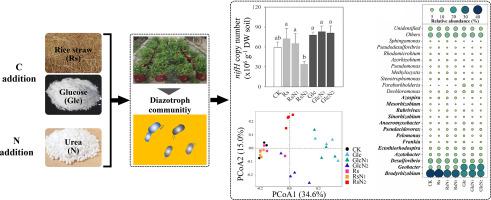当前位置:
X-MOL 学术
›
Appl. Soil Ecol.
›
论文详情
Our official English website, www.x-mol.net, welcomes your
feedback! (Note: you will need to create a separate account there.)
Carbon substrates exert a stronger role than mineral nitrogen application in structuring soil diazotroph communities during Chinese milk vetch growth
Applied Soil Ecology ( IF 4.8 ) Pub Date : 2021-02-01 , DOI: 10.1016/j.apsoil.2020.103778 Lu Yang , Robert M. Rees , Jun Nie , Changxu Xu , Weidong Cao
Applied Soil Ecology ( IF 4.8 ) Pub Date : 2021-02-01 , DOI: 10.1016/j.apsoil.2020.103778 Lu Yang , Robert M. Rees , Jun Nie , Changxu Xu , Weidong Cao

|
Abstract Carbon (C) quality and quantity and nitrogen (N) availability are known to play a crucial role in influencing diazotroph community structure in soils and they are commonly affected by crop residue management and fertilizer application. However, a full understanding of how C and N interactions contribute to shaping soil diazotroph communities remains elusive. An experiment comparing two different C substrates (rice straw vs. glucose) plus low to high rates of mineral N application was conducted in two paddy soils with contrasting pH (pH = 6.05 and 7.85) with Chinese milk vetch (CMV) growth. Soils were sampled during the full blooming stage of CMV and diazotroph community structure was characterized using the nifH marker gene. The results showed that the diazotroph community responded differently to C substrates (straw and glucose) depending upon the C availability. In both soils, mineral N addition decreased nifH gene copy numbers in the straw-included treatments, but not in the glucose-included soils. Compared to the straw-included soils, glucose addition resulted in less α-diversity of diazotroph. Meanwhile, diazotroph community structure was clustered into different groups by the C sources, and marginally affected by N levels. These results suggested that the responses of the diazotroph community to N supply were regulated by C availability. Glucose addition decreased the relative abundance of Bradyrhizobium compared to straw incorporation (16.0%–25.9% vs. 19.5%–38.2%), but significantly increased the abundance of the second most dominant genus Geobacter (12.8%–23.7% vs. 4.1%–8.7%). In addition, the diazotroph diversity and community structure were less responsive to straw, glucose and mineral N addition in the lower vs. high pH soils. Overall, the results suggest that the responses of diazotrophs to N availability rely on C availability in paddy soils, and that C substrates exert a stronger influence than mineral N application in structuring diazotroph communities.
中文翻译:

在紫云英生长过程中,碳底物在构建土壤固氮群落方面的作用比施用矿物氮更强
摘要 众所周知,碳 (C) 的质量和数量以及氮 (N) 的有效性在影响土壤中固氮菌群落结构方面起着至关重要的作用,并且它们通常受到作物残留管理和施肥的影响。然而,对 C 和 N 相互作用如何有助于塑造土壤固氮群落的全面了解仍然难以捉摸。在两种稻田土壤中进行了一项比较两种不同的碳基质(稻草与葡萄糖)以及从低到高的矿物质氮施用率的实验,这些土壤的 pH 值(pH = 6.05 和 7.85)与紫云英 (CMV) 生长形成对比。在 CMV 盛开阶段对土壤进行取样,并使用 nifH 标记基因表征固氮菌群落结构。结果表明,固氮菌群落对 C 底物(稻草和葡萄糖)的反应取决于 C 的可用性。在这两种土壤中,矿物质氮的添加降低了稻草处理中 nifH 基因的拷贝数,但在葡萄糖处理的土壤中没有。与包含秸秆的土壤相比,添加葡萄糖导致固氮菌的 α 多样性降低。同时,固氮菌群落结构被 C 源聚集成不同的组,并且受 N 水平的影响很小。这些结果表明固氮菌群落对 N 供应的反应受 C 可用性调节。与秸秆掺入相比,葡萄糖添加降低了慢生根瘤菌的相对丰度(16.0%–25.9% 与 19.5%–38.2%),但显着增加了第二大优势属地杆菌属(12.8%–23)的丰度。7% 与 4.1%–8.7%)。此外,在低 pH 和高 pH 土壤中,固氮菌多样性和群落结构对秸秆、葡萄糖和矿物质 N 添加的响应较小。总体而言,结果表明固氮菌对 N 有效性的响应依赖于稻田土壤中的 C 有效性,并且 C 基质在构建固氮菌群落方面比矿物氮施加更大的影响。
更新日期:2021-02-01
中文翻译:

在紫云英生长过程中,碳底物在构建土壤固氮群落方面的作用比施用矿物氮更强
摘要 众所周知,碳 (C) 的质量和数量以及氮 (N) 的有效性在影响土壤中固氮菌群落结构方面起着至关重要的作用,并且它们通常受到作物残留管理和施肥的影响。然而,对 C 和 N 相互作用如何有助于塑造土壤固氮群落的全面了解仍然难以捉摸。在两种稻田土壤中进行了一项比较两种不同的碳基质(稻草与葡萄糖)以及从低到高的矿物质氮施用率的实验,这些土壤的 pH 值(pH = 6.05 和 7.85)与紫云英 (CMV) 生长形成对比。在 CMV 盛开阶段对土壤进行取样,并使用 nifH 标记基因表征固氮菌群落结构。结果表明,固氮菌群落对 C 底物(稻草和葡萄糖)的反应取决于 C 的可用性。在这两种土壤中,矿物质氮的添加降低了稻草处理中 nifH 基因的拷贝数,但在葡萄糖处理的土壤中没有。与包含秸秆的土壤相比,添加葡萄糖导致固氮菌的 α 多样性降低。同时,固氮菌群落结构被 C 源聚集成不同的组,并且受 N 水平的影响很小。这些结果表明固氮菌群落对 N 供应的反应受 C 可用性调节。与秸秆掺入相比,葡萄糖添加降低了慢生根瘤菌的相对丰度(16.0%–25.9% 与 19.5%–38.2%),但显着增加了第二大优势属地杆菌属(12.8%–23)的丰度。7% 与 4.1%–8.7%)。此外,在低 pH 和高 pH 土壤中,固氮菌多样性和群落结构对秸秆、葡萄糖和矿物质 N 添加的响应较小。总体而言,结果表明固氮菌对 N 有效性的响应依赖于稻田土壤中的 C 有效性,并且 C 基质在构建固氮菌群落方面比矿物氮施加更大的影响。









































 京公网安备 11010802027423号
京公网安备 11010802027423号